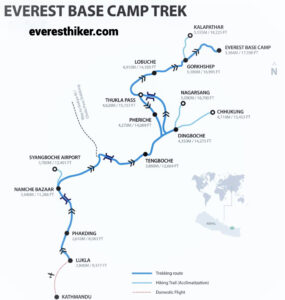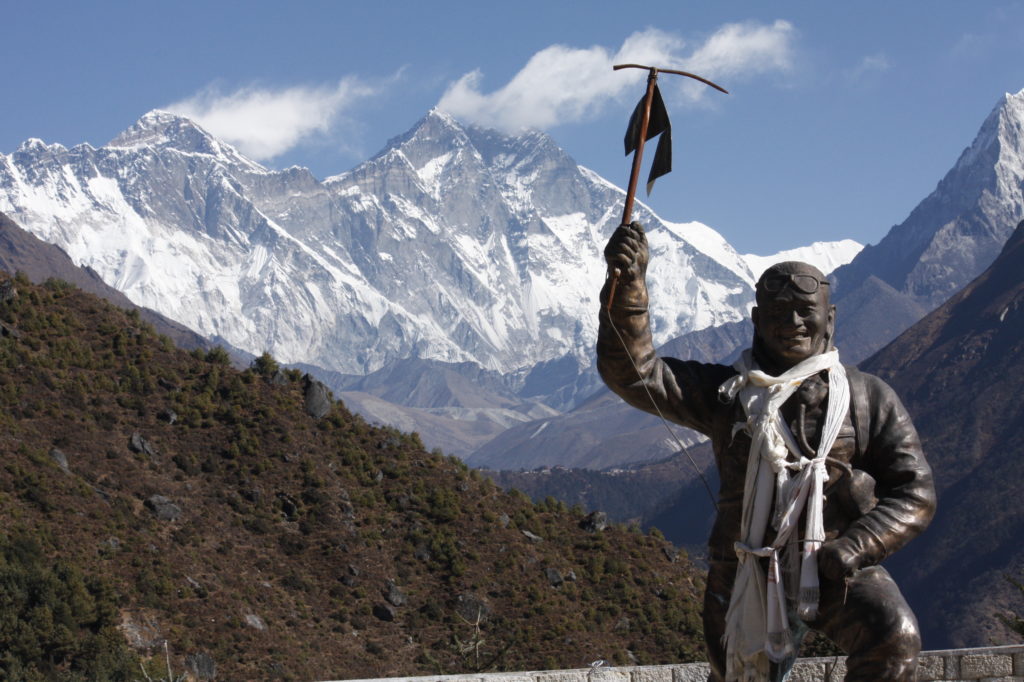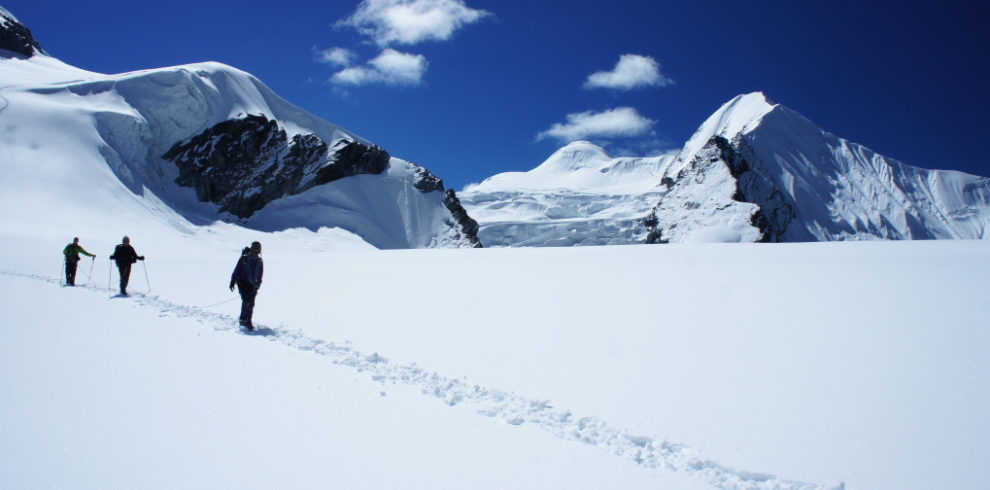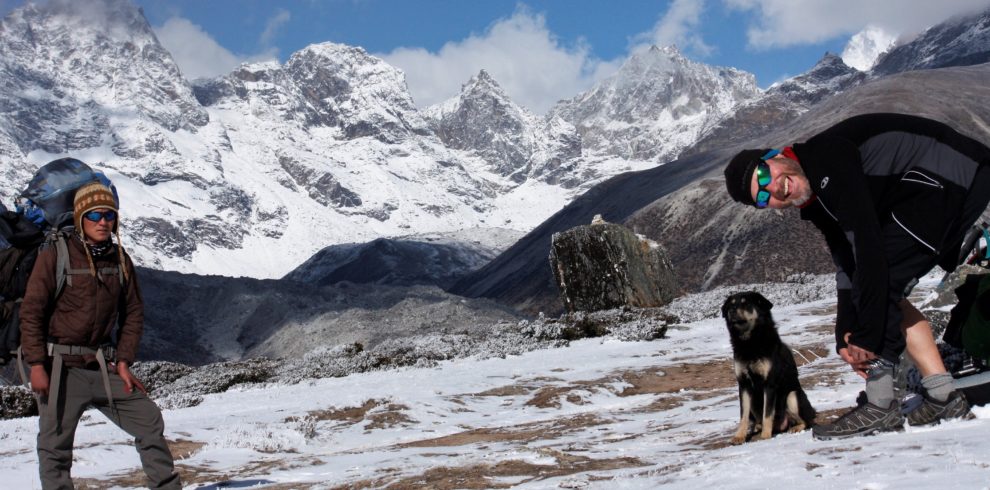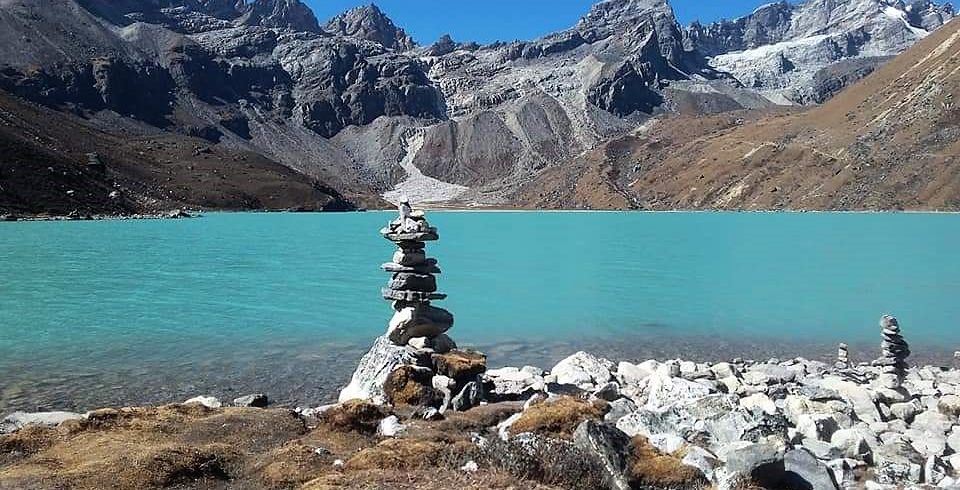Everest Panorama Trek is famous for a short Everest trek. Short 7 days Everest Panorama Trek is well known for a short trek in the world. Tengboche trek permits the traveler to get insights into the local Sherpa traditions. Moreover the opportunity to view nature and beautiful Himalayan sceneries. The short trek allows us to explore the world’s highest peak Mt. Everest and neighboring Himalayas. View at once glace from the Tengboche monastery could be best. Epic mountains view respectively Mt Everest, Amadablam, Lhotse, and Nuptse.
Anybody can explore Everest short Trek through Hiking or Helicopter. Everest panorama trek is arguably the greatest of all the time high-mountain trails. Moreover, we need adventure enthusiasts along with their, family members, and loved ones. Regardless of any risks of acute mountain sickness, age, and fitness levels. Everest trek temperately easy walking compared to Everest Base camp trek. In a short period, you can get an overall experience in the Everest region. Our valley exploration is all about 7 days Everest view trek.
Everest view Short Trekking
7 days trek offers a starkly imposing and wildly beautiful landscape. We will walk until Tengboche for a short Everest view trek. Those who have limited time available for Everest trek. The Everest route is famous for magnificent views of Himalayan giants. Tengboche Monastery the viewpoint of Mt. Everest, to be the best view. No one can forget the close-up views of Everest and other surrounding peaks from Tengboche.
We will surely visit an ancient Tengboche monastery. Whereas, the locals perform daily rituals and more. Our Everest panorama trek itinerary starts an elating board a scenic flight towards Lukla airstrip. We hike Namche Bazar up to the Dudh Koshi Valley which is encircled by the towering peaks of Thamserku and Kusum Kanguru. After a hardest steep ascent to Namche Bazaar, capital of the Khumbu Sherpas. Everest hiker has lots of Everest short trek reviews regarding this trip.
Location: Khumbu Region
Trekking Grade: Moderate
Activities: Tour and Trekking
Maximum Altitude: 3,800m
Season: Autumn (November)
Accommodation: Lodge Trek
Trek duration: 14 Days (10 Days for Trek)
Trekking Starting Point: Lukla
Trekking Ending Point: Lukla
Walking hour per day: 5 to 7 hours
Group Size: 2 to 8 pax
The Everest trek weather is a variety from spring (March to May) and autumn (September to December) are the best time. However, this Everest panoramic trekking is possible during the entire year around. Everest short trek is for all kinds of age people who love to explore the mountain kingdom.
Magnificent mountain panoramas once more greet us. There is more alternative Everest valley trek which offers stunning Everest short trek, Gokyo trek, and Everest 3 pass trek. Subsequently, another day we head to famous Tengboche, the same the way to Everest base camp. Everest Valley short
From Tribhuvan International Airport you will be transferred to your hotel room. In the afternoon you will be invited to our office for a briefing about each day program. Today you will receive your Sagarmatha National Park Permits and TIMS.
Pick up at Hotel and transfer to Kathmandu domestic airport. After a short morning flight to Lukla, you’ll be introduced to your guide and porter. Kick off your trek with a leisurely walk through Chaurikharka village and descent towards Dudhkoshi Ghat (2,530m/8,300ft). The trail follows the bank of the Dudh Koshi River until Phadking (2,652m/8,700ft), where we will be staying for the night to acclimatize. Enjoy your free time in Phadking, a popular stopping point.
You’ll have breakfast in Phadking before gearing up for the trek to Namche Bazaar, the biggest Sherpa village in Nepal. Your trail takes you first over the Dudhkoshi River via a long suspension bridge, and then through a beautiful pine forest to Monju, about two hours away. Soon after that, we will approach the entrance to Sagarmatha National Park for a brief permit check and then descend to Dudh Koshi River (spotting Mani stones along the way!) en route to Jorasalle. Lunch will be served here, and then it’s uphill to Namche. Your path along the riverbank is flanked by two crossings, one of which is the Hillary Suspension Bridge. It’s a tough climb up the hill to our resting place, but you'll be rewarded in Namche Bazaar with your first glimpse of Everest in its majesty.
Breakfast in Namche Bazaar fuels us for another day of trekking towards Everest Base Camp today! Break taking views of the Himalayas - Everest, Nuptse, Lhotse, Ama Dablam, Thamserku, and Kwangde - are some of the highlights not being missed. A short drop takes us to the riverside, and then it's across the river upwards through the forest pass. Brace your legs for a continual uphill trek at this point, alternating between a gradual grade and some seriously steep ground! Your destination, Tengboche, is known as one of the most beautiful places in the Everest region. Its views, which include Ama Dablam, are legendary. We'll stop in on the Tengboche monastery, which is one of the largest in Khumbu. Nourish your spirit with a guided tour of the monastery grounds, followed by chanting and prayer with the resident Buddhist monks.
Today we see a panoramic view of lots of mountains. From Tengboche, we can see Everest, Nuptse, Amadoplam, Thamserku, and more mountain. After seeing such fantastic view of Himalaya, we straight down until Dhudkhosi river. When we been Namche we descend to until a beautiful suspension bridge over Dudhkosi river and we came down until valley and reached Namche bazzar. Another night at Himalaya would be unforgettable.
We continue walking through several villages then we cross another suspension bridge. We finally reached the Phakding and more 2 hours we arrived Cheplung village for lunch. After lunch hours to arrive in Lukla brings an evening in a proper hotel and, traditionally, a party with your trekking crew: you made it! Thanks to great teamwork and perseverance.
In the morning, flight from Lukla to Kathmandu. Your journey both began and ends in Himalaya. You’ll pick up you and transfer to your hotel upon landing. For some much-needed solo rest and reflection. After your trek, you may explore Thamel buying gift and more.
All distances and time estimates are approximate flight time. We are coming for the pickup you at the hotel and for airport drop. Here is the day of goodbye mountain kingdom.
Cost Include
- Airport / Airport pick up & drop by private tourist vehicle.
- Three nights’ standard twin sharing accommodation in a three-star level hotel in Kathmandu; Breakfast included. (2 nights)
- All your standard Meals during the trek (Breakfasts, Lunches, and Dinners) with one cup of tea/coffee per day.
- Lodges, Guesthouses accommodation during the trek
- Licensed English speaking guide.
- The required number of local staff and porters to carry your luggage during the trek (We assign one porter for every two guests).
- Food, accommodation, salary, insurance, equipment, and medicine for all staff.
- Everest National Park permits and TIMS permit for trekking.
- Airfare from Kathmandu – Lukla – Kathmandu including airport departure tax in Kathmandu and Lukla airport.
- Surface transfer from and to Kathmandu.
- Farewell dinner in a typical Nepali Restaurant with on the second last day.
- All our government taxes, vat, tourist service charges.
- Official expenses.
Cost doesn't include
- Air travel to/from Nepal,
- Lunch & dinner in Kathmandu,
- Soft/hard drinks, laundry, postage, telephone bills, all items of personal nature,
- Personal clothing, insurance against accidental, medical and emergency rescue evacuations,
- Respective expenses if one returns earlier from the trip due to sickness or emergency purpose.
- Sightseeing around Kathmandu valley.
- Travel Insurance
- Emergency helicopter rescue evacuation arrangements will cover by travel insurance.
Check Gear list for Everest hiker
In most of the causes before start our adventure, we’ll spend a day or part of a day doing some casual sightseeing in world heritage site valley surrounding before we leave for the trek, and we’ll check gear when you arrive if anyone needs for the trek. Please have photos, passport photocopy airline tickets to re-confirm and insurance information ready if needed. Let’s us detail.
Recommend Day-pack for Everest hiker
We recommend a 30-45 liter Day-pack for each in case of porter hiring. Better to have it too large than too small, as on pass days you’ll want to carry more when you need. Most have internal water bladders built in, which are good to have it for any situation. Make sure it’s comfortable before leaving home. Mines are 55 and 65 liters.
Generally if you are going to hire porter in your daypack, you’ll be carrying 1 or 2 liters of water, a wind/Gortex/soft/ hard-shell jacket, wind/rain pants, hat & gloves, extra socks, sunscreen, snacks, water purifying tablets or filter, camera, a plastic bag or pack-cover and maybe a down jacket. Others remaining porter will assist you.
Packing/Storage
It’s easiest to pack and unpack from a duffel-bag, do for the most natural, porters to carry as well… Inexpensive and/or sound quality duffel are available in Kathmandu, but we can provide upon your request but it’s best to invest in a robust and waterproof duffel such as a North Face. You can leave/store extra gear in Kathmandu at our office storage room free of charge.
Extra Gear & Villagers
If anyone has old/extra/used gear of any sort, bring it along if you have room in your duffel you can donate it for porters and some orphans center or donation for villagers.
Our porters & staff also appreciate it can be old shirts, jackets, pants, fleeces, shoes to your old trekking socks. We often have a raffle on the first day of the trek, and each porter will get at least one ‘new’ thing, which is fun for them.
Recommend Snacks for Everest hiker
It’s always good to have some snicker or bars at lower elevations. You crave terrific things at altitude, and often need energy in a way that you usually don’t at lower altitudes energy bars, electrolytes, etc are essential for long days or passes. Lemonade mix, Emergen-C, Tang, etc great to have for hot days in your water bottles it can make huge differ. If anyone has a favorite cookie/biscuit, bring a package to share in the tent in the evenings with staff if you want. And anything else that you can bring particularly likes.
Water Purifiers & Filters
You can bring an MSR ceramic purifying/filtering pump along on the trek which everyone can use to pump fresh water in the evenings for the next day’s drinking water, ecologically the best way to get water in the Himalaya’s fragile trekking regions. Bring your pump, UV purifier or iodine tablets to have the capacity for fresh water whenever you want in route. Please bring at least unbreakable plastic/metal water bottles.
What we need for Everest trek
A copy of your travel medical insurance (just one sheet with policy number, name, and international contact numbers) as well as password photocopy.
A copy of your Passport (front page) and Nepal visa
3 Visa-sized photo
Cash for Everest trek
We run trek basis on beautiful during the trek for drinks, snacks, candy bars, biscuits, beer, etc. There’s some good shopping in Namche, sometimes a chance to buy locally made products. For tipping the crew we recommend about $100 per person in Nepali rupees or USD. There are ATMs in KTM which give you 350 USD, and many money changers, banks, etc available in Kathmandu and Lukla. In Namchhe, you can change TCs or cash, and some other places cash but we recommend you do it in Kathmandu. Guide also have extra rupees with them if anyone runs out and needs to borrow. For each Everest hiker, $250 is an excellent amount to change when you arrive in KTM.
Camera/ mobile Batteries recharge system
There are now many places to recharge batteries in the Everest, Annapurna, Manaslu and Langtang region so bring your camera battery chargers otherwise bring your solar panel. We recommend always bringing extra batteries as it takes time to charge and there is often a line in busy time, charging is not always available and it can get expensive to charge your batteries up higher!
Washing & Showers in Everest trek
Showers are almost always available at the lodges of Everest regions. But they’re not cheap generally per head 3-5USD up to. So budget some extra cash if you like to shower daily! You can have (at no cost) a ‘warm washing bowl’ to wash up with. As for clothes, bring a small package of soap powder, and you can either wash your clothes yourself or laundry available in Namache our porters some money to wash them for you! That sometimes works.
Sleeping bag for Ebc trek
Down-filled sleeping bags rated to -10º are best because high altitude nights will be fresh for hikers but for peak climber more than…Good down is fluffy, light and thick. A muff makes a big difference to the overall warmth of a bag and a mummy bag is generally warmer than a rectangular one. If your bag is rated for a higher temperature add a fleece sleeping bag liner to add warmth to the alpine zone.
Day-pack for everest base camp trek
This should be comfortable in your choice, with a right waistband that transfers some of the weight to the hips. It needs to be big enough to take a jacket, fleece, drinking water, camera and odds and ends you might like during the day which should be always with you.
Duffel Bag for Everest hiker
If you travel with porters, bring your gear in a duffel bag which help to excess easy. Several companies make good duffel bags with a zipper along the side for ease of entry choose the best one. Get a bag that is durable and has a sturdy zipper some time it makes different. A duffel bag 40cm in diameter and about 80cm long is large enough to carry your gear and will usually meet the weight limit of porters and domestic flights rules.
Recommend Trekking Boots, for Everest trek
To finish happily trek you need comfortable feet. Quality boots have good ankle support, plenty of toe room for long descents, a stiff sole to lessen twisting torsion and are light, due to you don’t tire. Look at the inner lining – leather is good and Cambrelle is even better, a material that eats smelly foot bacteria and makes the extra relief. Good lightweight trekking boots or light all leather boots are ideal for a long day trek. Avoid arriving with brand new boots that you have not yet used before! Walk in your new hiking boots on some steep hills and make it smooth that will test trouble spots before you leave home. The longer the trek, the better the boots you need, so took the best one for a happy journey.
Socks,
In the low country area, your feet will be warm or even hot while walking so quality cotton mix sports socks are excellent. Three to four pairs are enough for the trek. Thick trekking socks are better for higher up because you may walk in the snow, and evenings are cold where you can exchange. We suggest you bring four pairs or even 1 more. Most modern trekking boots fit snugly so wearing two pairs of socks at the same time is impractical to think twice.
Camp Shoes,
Luxury for your feet at the end of the day: sandals or running shoes is the best idea.
Fleece top,
Most trekkers consider this is essential, but alternatives are a thick thermal top or a light down jacket. In Kathmandu, you can get cheap Korean fleeces but they are not the best quality you needed.
Down Jacket or fiber-filled jacket,
Down clothing has the advantage of being light and compressible for alpine. A down jacket will stuff into a small space when packed, yet puff up. You should bring a good down jacket on all treks from your country or can buy in Kathmandu. Most ski jackets that have been used in your country are not warm enough and most so-called expedition parkas are too heavy and bulky. Don’t bring both a heavy and a light down Jacket; choose one that will serve both purposes, preferably ideal one with a hood that is also stuffed with down. If you feel extremely cold at high altitude, you will likely to wear your down jacket inside your sleeping bag.
Wind or rain jacket
During the day trekking, you can use windproof, Waterproof and breathable. Plastic ponchos or non-breathable raincoats are not suitable for the trek.
Fleece/sweatpants,
Great for the chilly evenings, thicker is better and polypro is better than cotton in high.
Day-wear shirt,
T-shirts are favorite but a shirt with a collar and long sleeves are more practical during the day or in the evening. Regularly you can use two so you can swap damp for dry. Look one for shirts made of quick dry fabrics rather than cotton.
Trekking pants,
You will live in these. Light material, loose fitting, and dark-colored are best.
You can survive with only one pair but you have to bring two; get dusty or muddy so a change is a good idea. Cotton cheapies some marks in the local fashion, it is not necessary to have gore-tex or waterproof pants.
Neck gaiter,
For winter trekking they are the best for staying warm you need it, A fleece triangle with a Velcro fastening works well and is easy to pull up when the yaks stir up trail dust.
Trekking poles,
Useful, especially on steep, rough terrain, but if you are not used to using them you will not miss them someone who loves to do photography thinks twice.
Sunglasses,
Highly recommend good one suitable for snow, as it is bright up there, but specialized glacier glasses. Contact lens wearers report very few problems except cleaning them in the conditions it’s your matter. Ski goggles are unnecessary for trekking.
Mittens/Gloves,
These don’t need to be fancy (pockets are the warmest solution to cold hands), so local Kathmandu fleece gloves are excellent but you need it.
Water bottle,
Should be a one-liter size, except boiling water, and be leak-proof. You have to bring 2 or liter capacity in all. Sometimes mini Thomas a metal bottle can double as a hot water bottle on cold nights.
Torch,
LED bulbs are best for mountains. You will need a lamp for reading after dark, and for finding your way to the outhouses. A headlamp is excellent for climbing although many people prefer the second torch it’s enough.
Toiletries and odds and ends,
Bring essentials for the trek only otherwise you can buy in tea houses. There are a surprising number of showers or buckets of hot water available in the hotel. The smallest tube of toothpaste is perfect for a month in your favor. Roll-on deodorant can spare you grief with your tent partner toilet paper need. Hand cleaner in a bottle (“Purelle” or similar) is a good idea, it would be better for the environment than “handy wipes”.
Towel,
Bring only a small one for trekking, or consider using a sarong. Mountain shops sell towels made of a quick dry fabric which is cost around 10USD. In Kathmandu, city hotel do supplies towels. Sunscreen and lip care with sun protection extremely needed during the day sun is intense at altitude, especially after snow, and you will want to use these most days.
Water purification,
One bottle of iodine tablets between two, Douglas or Potable Aqua is the best one. Shops in Canada sell Pristine, which is a good option. We tend to use boiled water from the lodges but occasionally we need to take water from the streams. The use of mineral water bottle is discouraged from an environmental point of view and the higher it cost more.
Snow gaiters
These are not needed, but bring them if you already have some in case we get or cross a pass about 5400M high or you are coming in the winter season.
Evening camp wear,
Around the evening camp, you can wear camp shoes, lights sandals or leather boots. No matter what altitude and what season the temperature can get to -10º after dark. By far the best clothing is:
+ A down jacket, medium weight
+ Thick fleece pants
+ Fleece hat and neck gaiter
+ Thick shoes with wool socks
Available in Kathmandu or bring from home that we need.
1) Sleeping sheet
2) Duffel Bag
3) Trekking pants
4) Wind pants
5) Fleece top
6) Warm hat
7) Light gloves
8) Toilet paper
9) One litter of water bottle
10) Pee bottle
11) Lip care
12) Torch
13) Snow Gaiters
14) Water purification
Bring from home
1) Sleeping bag
2) Daypack
3) Trekking Boots
4) Running shoes
5) Socks
6) Camp shoes
7) Rain jacket
8) Nightwear top
9) Neck gaiter
10) Daywear shirt x2 or 3
11) Underwear
12) Sun hat
13) Sunscreen
14) Sunglasses
15) Toiletries and odds and ends
16) Small towel/sarong
17) Personal medicines
18) Camera
19) Money pouch/belt
20) Passport photos 2x
21) USD40 cash for a visa (30 days visa)
Everest panorama trek info
Mainly you have to be fit physically and mentally for Everest view trek. You usually have to walk 4-6 hrs per day until the height of Tanbouchge monastery. So you have to prepare your body and mind that you can walk 4-6 hrs per days for 7 days Everest view trek. First days would be easy overnight at Phakding.
Your trail takes you first over the Dudhkoshi River via a long suspension bridge, and then through a beautiful pine forest to Monju, about two hours away. Soon after that, we will approach the entrance to Sagarmatha National Park for a brief permit check and then descend to Dudh Koshi River (spotting Mani stones along the way!) en route to Jorasalle. Lunch will be served here, and then it’s uphill to Namche. Your path along the riverbank is flanked by two crossings, one of which is the Hillary Suspension Bridge. It’s a tough climb up the hill to our resting place, but you’ll be rewarded in Namche Bazaar with your first glimpse of Everest in its majesty. The final day of trekking towards Everest Base Camp today! Break taking views of the Himalayas – Everest, Nuptse, Lhotse, Ama Dablam, Thamserku, and Kwangde – are some of the highlights not being missed. A short drop takes us to the riverside, and then it’s across the river upwards through the forest pass. Brace your legs for a continual uphill trek at this point, alternating between a gradual grade and some seriously steep ground! Your destination, Tengboche, is known as one of the most beautiful places in the Everest region. Its views, which include Ama Dablam, are legendary. We’ll stop in on the Tengboche monastery, which is one of the largest in Khumbu. Nourish your spirit with a guided tour of the monastery grounds, followed by chanting and prayer with the resident Buddhist monks.
Everest view trek is known as 7 days short trek in the Everest valley. It’s about quick going up 3860m with 3 days trek. Even it is a short Everest view trek but must have some equimants Daypack is needed during the hiking, if you trekking with organized trip than (25–35 liters), day-pack is great enough but if you are doing on your own then you must have to choose (50-60 liters) Pack cover necessary, is your choose Sleeping bag comfortable too -5 °c (depending upon the season any way our Everest hiker team will provide extra blanket for each clients. weather forecast and personal preference). It is possible to rent it in Kathmandu which cost 3$ per day. Waterproof (optional) hiking boots are the most strongly with a familiar one, Camp shoes (down booties or running shoes) LED headlamp with quality one along with extra battery, 1 trekking poles for each. Camelback water bladder or sipper (water bottle) about 1 per pax. We need some Chocolates, Energy bar, Dry fruits, ORS and elector light drink. Most of the second hand or new equipment’s you can hire or buy in Kathmandu. And the cost will be cheaper for you to compare your country. And the more extra light jacket. With regular down jacket T-shirt, goggles (UV protected) and 2 pair thermal pants and cap for sun cover, Wat gloves, woolen standard gloves, and socks. Sunscreen, moisturizer, lip balm and sanitize handy that’s all.
Starting from the far west of Dhodh Kosi valley. it crosses Renjo La pass to get into the Gokyo valley region. You have time here to visit the emerald many lakes in such high altitude that called Gokyo its name.
The trail continues goes over the Cho La pass into the Dudh Kose valley and Everest base camp trek. From here it heads up to Everest base camp and khongma la pass. After viewing spectacular view from kalapather we back to labouche for another pass. Finally, it heads back down and crosses the Kongma La pass arriving in the Imja Khola valley at Chukung village. In route, you will submit three great 5000m peaks: Gokyo Ri, Kalapatar, Everest, and Chukung Ri.
